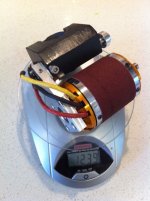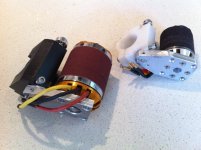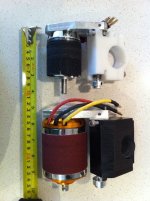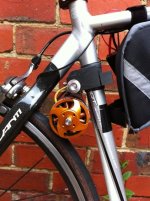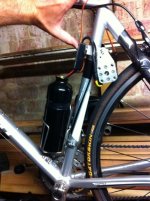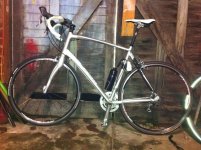Not sure. I think it was Kepler that said this is the optimum engagement, to be able to draw the straight line between motor pivot, contact patch, and wheel hub. I don't quite agree and have been setting up my drives to limit the travel before that point with success.
I think I outlined my reasoning in
this earlier post. But I have not totally convinced myself so take it with a grain of salt.
I can still have the same amount of engagement with the tyre but at an angle. The allowable angle is dictated by the coefficient of friction between motor and tyre. Come to think of it this will be the worst when the motor is first coming in contact with the tyre when you will have the largest angle. This could be improved by increasing the radius at whcih the motor pivots.

Damn. That is a good argument for a longer pivot arm.

Funnily enough now that I have a single pivot arm, I could fairly easily do this by placing my pivot point infront of the seat tube, and having a longer pivot arm. Hmmm. It would increase weight, but may help avoid slip during initial pick up. But it would also require the drive to pivot further to have the same engagement into the tyre. So it wouldn't help trying to get it on smaller framed bikes. Damn.
From my understanding of the geometry, the most critical time it will slip is during initial engagement for the pivoting designs like mine and Keplers. Once it gets over that point the geometry will only be able to apply more contact force until it is limitted by a force balance, or deadstop. If you slip at the fully engaged position you would need to adjust the drive such that you acheive more engagement, ie. lower the drive, or adjust the deadstop.
To directly answer your question. Yes the geometry of the frame does limit the travel of the CB, and could restrict engagement. But you don't need to aim to have a fully straight line between motor pivot, contact point, and rear wheel hub. You can stop short of this and have just as much tyre engagement.
- Adrian
P.S. One of the other reasons I don't let the drive pivot that far, is that you see a drop off in the torque required to maintain the drive in that position as you get closer to the straight line. This means the drive suddenly accelerates its rotation towards the deadstop, and hit is with a bit of a clunk. I was previously just adding a dampening material to my deadstop, but by adjusting the geometry I effectively used the compliance of the tyre to do the job instead.



